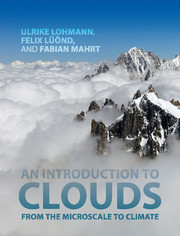Book contents
- Frontmatter
- Dedication
- Contents
- Preface
- List of symbols and acronyms
- 1 Clouds
- 2 Thermodynamics
- 3 Atmospheric dynamics
- 4 Mixing and convection
- 5 Atmospheric aerosol particles
- 6 Cloud droplet formation and Köhler theory
- 7 Microphysical processes in warm clouds
- 8 Microphysical processes in cold clouds
- 9 Precipitation
- 10 Storms and cloud dynamics
- 11 Global energy budget
- 12 Impact of aerosol particles and clouds on climate
- References
- Index
Preface
Published online by Cambridge University Press: 05 June 2016
- Frontmatter
- Dedication
- Contents
- Preface
- List of symbols and acronyms
- 1 Clouds
- 2 Thermodynamics
- 3 Atmospheric dynamics
- 4 Mixing and convection
- 5 Atmospheric aerosol particles
- 6 Cloud droplet formation and Köhler theory
- 7 Microphysical processes in warm clouds
- 8 Microphysical processes in cold clouds
- 9 Precipitation
- 10 Storms and cloud dynamics
- 11 Global energy budget
- 12 Impact of aerosol particles and clouds on climate
- References
- Index
Summary
Clouds, in their various forms, are a vital part of our lives. They are a crucial part of the global hydrological cycle, redistributing water to Earth's surface in the form of precipitation. In addition, they are a key element for the global energy budget since they interact with both shortwave (solar) and longwave (terrestrial) radiation. These so-called cloud–radiation interactions depend strongly on the type of cloud. Clearly clouds affect the global climate and thus understanding clouds is an important factor for future climate projections. The effects on Earth's energy budget and on the hydrological cycle both depend on processes on the microphysical scale, encompassing the formation of cloud droplets, ice crystals, raindrops, snowflakes, graupel and hailstones.
Establishing an understanding of clouds and precipitation requires a knowledge of the environment in which they form, i.e. the atmosphere, with all the gases and airborne particles present there. The latter are usually referred to as aerosol particles and encompass a wide range of solid and liquid particles suspended in air. Some aerosol particles can act as nuclei to form cloud droplets or ice crystals and thus initiate the formation of clouds or change their phase from liquid to solid. Thus they influence the microphysical properties of clouds. In turn aerosol particles are removed from the atmosphere when clouds precipitate. In order to gain a complete picture of the behavior of clouds in the atmosphere, the strong interplay between aerosol particles and clouds requires one to tackle the subject in an integrated approach.
This book is intended to offer a fundamental understanding of clouds in the atmosphere. It is primarily written for students at an advanced undergraduate level who are new to the field of atmospheric sciences. The content of this book evolved from the atmospheric physics lectures held at ETH Zurich. This book is intended to serve students with a multidisciplinary background as an introduction to cloud physics, assuming that most readers will have a basic understanding of physics.
The book is organized into 12 chapters, each focusing on a particular topic. Chapter 1 introduces the major cloud types found in the atmosphere and discusses them from a macroscopic point of view. Chapters 2–4 focus on the meteorological conditions and atmospheric dynamics needed for cloud formation and the thermodynamic principles needed to describe atmospheric processes, including phase transitions.
- Type
- Chapter
- Information
- An Introduction to CloudsFrom the Microscale to Climate, pp. xiii - xvPublisher: Cambridge University PressPrint publication year: 2016



